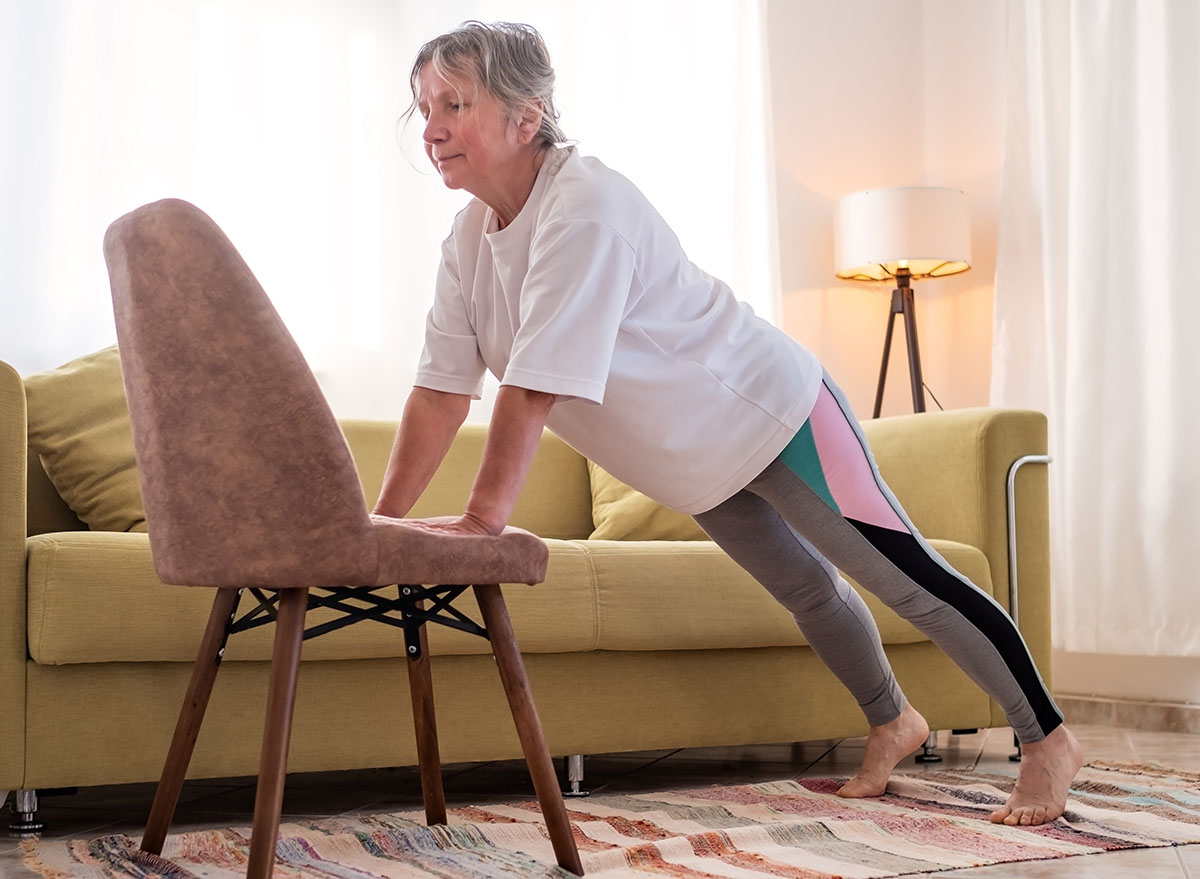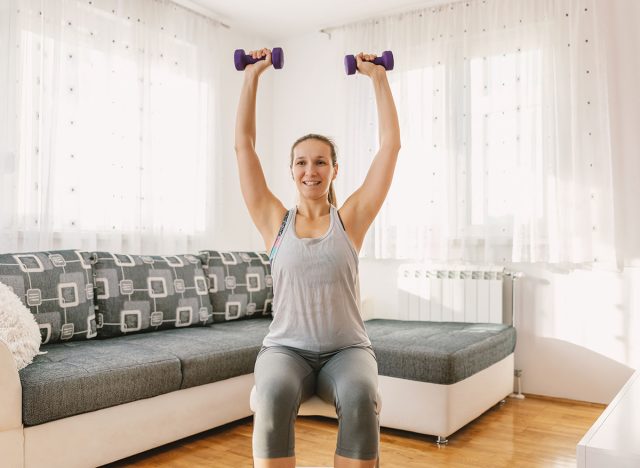4 Chair Exercises That Shrink Arm Jiggle Faster Than Weights After 55

Most people over 55 want arms that look firm, strong, and ready for anything. You gain that look when your upper-body muscles work through real tension and full ranges of motion. A simple chair gives you everything you need to create that effect in a safe and controlled way. Your shoulders, triceps, and upper back respond quickly when you use your own bodyweight with smart leverage, making chair training surprisingly effective for tightening the backs of your arms.
Chairs create stability. Stability gives your muscles a chance to work harder without straining your joints. When your body stays grounded, you can focus on the contraction of each rep, which is the secret sauce for shrinking arm jiggle. You also get a natural way to progress or regress each move by changing angles, tempo, or your foot position. This level of control helps you build strength without stressing your wrists or elbows.
The four chair exercises below target the exact muscles that create shape and tone through your arms. You will train your triceps, shoulders, and upper back with a mix of pushing and stabilizing actions. Each move delivers real tension, real burn, and real results. Let’s break them down so you can start feeling stronger right away.
Chair Dips
Chair dips load your triceps with direct tension, which is the fastest way to tighten the back of your arms. The movement places your elbows through a deep bend, and that range forces your triceps to contract harder than most bodyweight exercises. Your shoulders and chest assist as stabilizers, which increases overall upper-body workload. Slower reps produce an even stronger burn, which accelerates definition and firmness.
Muscles Trained: Triceps, shoulders, chest, upper back stabilizers
How to Do It:
- Sit on the front edge of your chair and place your hands beside your hips.
- Walk your feet forward and lift your hips off the seat.
- Lower your body by bending your elbows to a comfortable depth.
- Press through your palms and straighten your arms to return to the top.
- Keep your chest tall and your elbows directed back to keep tension on your triceps.
Recommended Sets and Reps: Perform 3 sets of 10 to 15 reps. Rest for 45 seconds between each set.
Best Variations: Bent-knee dips, straight-leg dips, tempo dips
Form Tip: Squeeze your triceps at the top of each rep to lock in the contraction.
Seated Arm Raises
Seated arm raises train your shoulders and upper back with controlled tension that tightens the muscles framing your arms. The seated position removes momentum and forces your deltoids to work harder. Longer time under tension produces more toning, especially when you keep your arms level with your shoulders. This movement also improves posture, which helps your arms look firmer and more athletic.
Muscles Trained: Shoulders, upper back, triceps, core stabilizers
How to Do It:
- Sit tall with your feet planted on the floor.
- Extend your arms straight out at your sides.
- Raise your arms until they reach shoulder height.
- Lower them with control to keep tension in your shoulders.
- Keep your chest tall and your arms long during every rep.
Recommended Sets and Reps: Knock out 3 sets of 12 to 20 reps. Rest for 45 seconds between each set.
Best Variations: Front raises, diagonal raises, slow-tempo raises
Form Tip: Keep your ribs down to prevent your lower back from arching.
Chair Plank Walkouts

Chair plank walkouts recruit your triceps, shoulders, chest, and core all at once. The forward reach increases tension through your arms and forces your stabilizers to control each inch of movement. This level of total-body engagement delivers more strength and firmness than many weighted exercises. Slow steps backward and forward increase the time your arms spend under tension, which improves muscle tone quickly.
Muscles Trained: Triceps, shoulders, chest, core
How to Do It:
- Stand behind your chair and place your hands on the seat.
- Walk your feet back until your body forms a straight line.
- Hold the plank position briefly.
- Walk your feet forward and return to the starting position.
- Keep your core tight and your arms long during the movement.
Recommended Sets and Reps: Perform 3 sets of 8 to 12 walkouts. Rest for 45 seconds between each set.
Best Variations: Slow walkouts, extended-hold walkouts, alternating-hand walkouts
Form Tip: Keep your hips level so your arms do the work.
Seated Overhead Press

The seated overhead press strengthens your shoulders and triceps with strict, controlled tension. The chair removes momentum, which forces your upper body to lift and stabilize entirely through muscular effort. Each press teaches your arms to generate force through a long range of motion, which sharpens definition. Consistent practice improves shoulder mobility, upper-body power, and visible firmness through your arms.
Muscles Trained: Shoulders, triceps, upper back, core stabilizers
How to Do It:
- Sit tall with your elbows bent and your hands near shoulder height.
- Press your arms overhead until they straighten comfortably.
- Lower your elbows back to shoulder level with control.
- Keep your ribs down during each rep.
- Maintain a strong, tall posture from start to finish.
Recommended Sets and Reps: Perform 3 sets of 10 to 15 reps. Rest for 45 seconds between each set.
Best Variations: Narrow-grip presses, wide-grip presses, slow-tempo presses
Form Tip: Press straight up rather than forward to keep shoulder tension consistent.
The Best Tips for Stronger, Firmer Arms After 55

Firm, defined arms depend on more than a few workouts each week. Your muscles respond to how you train, how you fuel yourself, and how consistently you repeat the process. Every choice you make during the day can support strength, recovery, and tone. When your habits line up with your training, your results show up faster and stay longer. These simple actions keep your arms strong, capable, and ready for the demands of daily life.
- Train consistently: Regular sessions keep your muscles engaged and improving.
- Increase protein intake: Fuel your muscles with nutrients that support recovery and growth.
- Add daily movement: Walking and light cardio raise calorie burn and improve muscle definition.
- Prioritize hydration: Water supports muscle function and helps your body recover.
- Stretch often: Mobility work keeps your shoulders and elbows moving smoothly.
- Focus on sleep quality: Strong recovery starts with consistent rest.